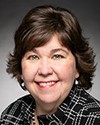We have what we call a community safety planning initiative where we work with indigenous communities. One of the biggest challenges with an indigenous community is their capacity to do the work. There is a lot of teaching that has to happen before they can actually even apply for programs.
First we contact the mayor or the chief of a community. Would you be interested in us helping you build your capacity to understand what your risks are in your community, what your strengths are, and how you could build a plan to become a safer community?
The actual impetus behind this was to support missing and murdered indigenous women and make safer communities for women and girls. Women and girls benefit from a safe community. You can't just deal with them in isolation. We go into the community after the chief has, with their influence, gotten a group together. It's usually men and women, but often more women, from their community. They have to be committed to this. We then hire a facilitator. We go with the facilitator to teach them, first, here's what you need to do. What do you have in your community? What are your problems? Where do you think your biggest risks are? What are some of the things you as a community could do to help?
We go back a second time to look at that a little bit more with them and help build their capacity. The third time we go with them is to actually develop the community safety plan. It's a pathway for them to build up their community and identify some of the things they need to improve and where their gaps are.
At that stage, they are in a position to actually benefit from, and provincial and federal governments are in a better position to target, programs that help them. They can now realize where the problem is—i.e., we actually have a community centre here that we could change into a drug and addiction centre to help our youth. They might do that. Or we can work with our colleagues at health and say there's a big health issue and they need help here, so can you use that program? The community itself has a better capacity to identify these programs, do outreach, and see what's in their own community. This way we can engage provinces and territories to say, okay, we have this community safety plan, so what can you do to help?
We have 80 communities—




